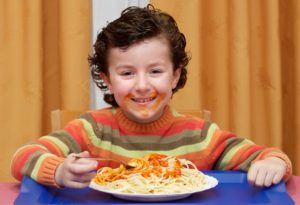
Dinnertime has always been an important time of our family’s day. It is the part of the day that we share the day’s events, discuss problems, as well as dreams. When our daughters were young dinnertime was perhaps only twenty minutes, and gradually grew to be an hour. Now that they are grown we enjoy long leisurely meals along with each other’s conversation and company.
Dinners, though, started out as a big mess, and we have the pictures to prove it. Faces smeared with refried beans. Strawberry ice cream hair-do’s. Here are some hints to go from messy meals to slow food dining. Remember, this is probably a ten-year plan, at least.
Spills happen. Be prepared for the spilled milk, the toppled plate, the spaghetti on the floor. Have cleaning supplies handy, and quietly without fanfare clean it up. We used waffle-weave kitchen towels as napkins for many years. They were handy, absorbent, and abundantly washable.
Think small and big.
Consider using smaller glasses and cups for your children and fill them only halfway. Our kitchen was large enough to accommodate a child-sized table with chairs that the girls used for snack time as well as other activities. At a child sized table children are better able to sit and maneuver utensils and food.
At the dinner table, think of how you can boost your child to table level easily using booster chairs or even specially designed chairs that they can climb in and out of independently. Consider how you might feel if you had to eat in a chair with your feet dangling and your chin barely above the tabletop.
Use indirect preparation.
Help your children develop skills away from the table that will help them. Show them how to clean up spills using water. Set up two bowls and let them spoon dried beans back and forth between the two bowls to practice handling a spoon. Buy a small pitcher and let them practice pouring dried beans and then liquids. Think about the skills they need to learn to be successful at the dinner table and focus on the steps necessary to get there.
Slow down.
Our adult movements are often too fast for our children to follow and imitate, which is how young children learn. Slow down. Once you sit down at the table, stay seated and try not to get up and down. Make your movements slower and more intentional. When you do, you’ll see your children slowing down and having fewer mishaps at dinner. Practice the art of dinner conversation. Make sure the television is off. It is a huge distraction to learning dinnertime skills.
Savor the experience.
Imagine yourself around the table with the people you love most in the world. You are eating fabulous food on an ocean cruise. But then every ten seconds someone says––Be careful. Don’t spill that. Finish your green beans. Drink your milk. Wipe your mouth. Sit up straight. Put your napkin on your lap. Sort of ruins the experience.
When you are at the table, enjoy. Enjoy the meal. Enjoy the people.
To teach manners, use indirect preparation by giving short lessons before or after dinner on how to use a napkin, how to sit up straight, how to be careful with your drink, and all those little nagging things we say to children at the dinner table.
Avoid mealtime messes by being prepared for the inevitable spills. Prepare your child’s space with the right sized utensils and furniture. Slow down and model what it is to be an adult who enjoys eating and being with the people they love.

